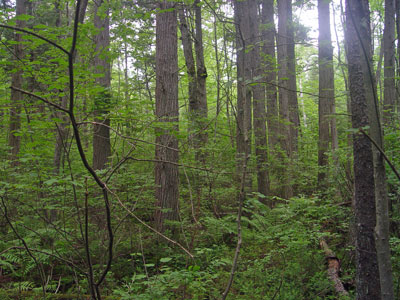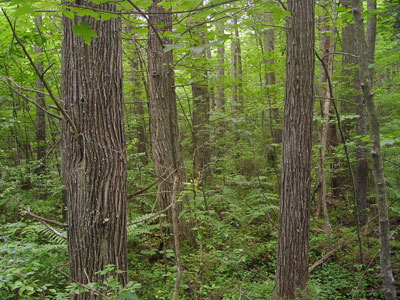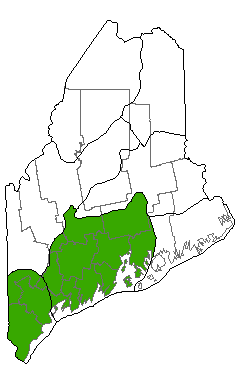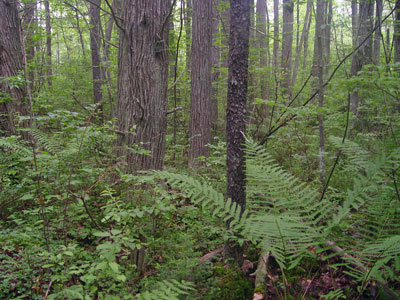DACF Home → Bureaus & Programs → Maine Natural Areas Program → Communities, Plants, and Animals → Natural Community Fact Sheets → Atlantic White Cedar Swamp
Printer Friendly Fact Sheet - 1.1 MB pdf (Get a free copy of Adobe Acrobat Reader)
Atlantic White Cedar Swamp
Common Name: Atlantic White Cedar Swamp; State Rank: S2

- Community Description
- Soil and Site Characteristics
- Diagnostics
- Similar Types
- Conservation, Wildlife and Management Considerations
- Distribution
- Characteristic Plants
- Associated Rare Plants
- Associated Rare Animals
- Examples on Conservation Lands You Can Visit
Community Description: These densely forested communities allow little direct light to the forest floor. The canopy is usually a uniform cover of Atlantic white cedar with occasional black spruce and red maple; in some sites, red maple may be co-dominant. The ground is a mosaic of moss covered hummocks and hollows. Where light penetrates the canopy, shrubs such as highbush blueberry, black huckleberry, mountain holly, or winterberry may be prominent. The herb layer features dense patches of tree regeneration in some openings. Herbaceous species are typically more abundant than dwarf heath shrubs. Back to top.

Soil and Site Characteristics: Atlantic white cedar swamps are underlain by shallow peat over mineral soil, or, less commonly, by mineral soil with little organic matter. They are flat, found in poorly drained depressions where standing water is present at least part of the year. All are at less than 300' elevation. Back to top.
Diagnostics: These wetlands have greater than 60% tree canopy cover. Atlantic white cedar is dominant or at least common. Evergreen shrubs are often present. Back to top.
Similar Types: Northern White Cedar Swamps may be compositionally similar except for the dominant species. Other similar types lack Atlantic white cedar, except for Atlantic White Cedar Bogs, where the trees are stunted, the canopy is well under 60%, and the peat moss substrate is deep (> 50 cm). Back to top.
Conservation, Wildlife and Management Considerations: Most occurrences of this community type occur in rapidly growing southern Maine. Because of this and because the timber is valuable, these occurrences are vulnerable. All of Maine's stands have been harvested in the past; some are now mature. Their perpetuation appears to be partially dependent on disturbance events such as blowdowns or fire. In the absence of such events, cedar may be replaced by more shade tolerant species such as red maple and hemlock. The quality of Atlantic white cedar swamps may also be impaired by filling, water quality degradation, water level changes, and timber harvesting.
These forested wetlands provide habitat for a variety of conifer nesting birds and for the rare Hessel's hairstreak butterfly, which feeds on Atlantic white cedar in its larval stage. Back to top.
Distribution: Along the entire Atlantic coastal plain north to central Maine. They have been greatly reduced in extent and are one of the rarest forest types in the eastern US. Landscape Pattern: Small to Large Patch. Back to top.


Characteristic Plants: These plants are frequently found in this community type. Those with an asterisk are often diagnostic of this community.
- Canopy
- Atlantic white cedar*
- Black spruce*
- Red maple*
- Sapling/Shrub
- Atlantic white cedar*
- Mountain holly*
- Dwarf Shrub
- Labrador tea*
- Sheep laurel*
- Herb
- Canada mayflower
- Cinnamon fern*
- Creeping snowberry
- Goldthread*
- Pitcher plant
- Starflower
- Three-seeded sedge
- Wild sarsaparilla*
- Bryoid
- Dicranum moss
- Sphagnum mosses*
- Three-lobed bazzania
- Hessel's hairstreak
Examples on Conservation Lands You Can Visit
| Example | County |
|---|---|
| Appleton Bog Preserve | Knox Co. |
| Massabesic Experimental Forest | York Co. |
| Mt. Agamenticus | York Co. |
